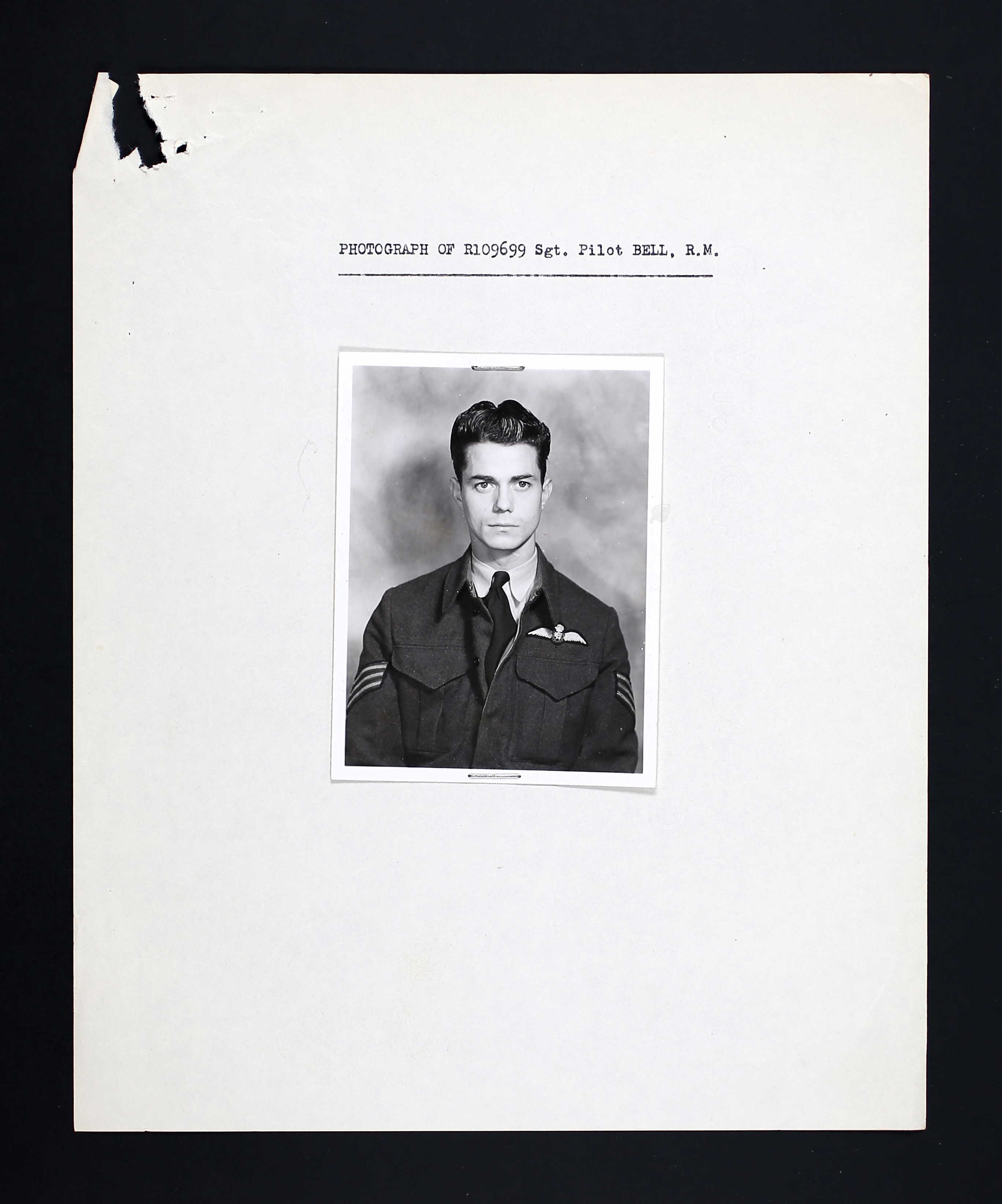
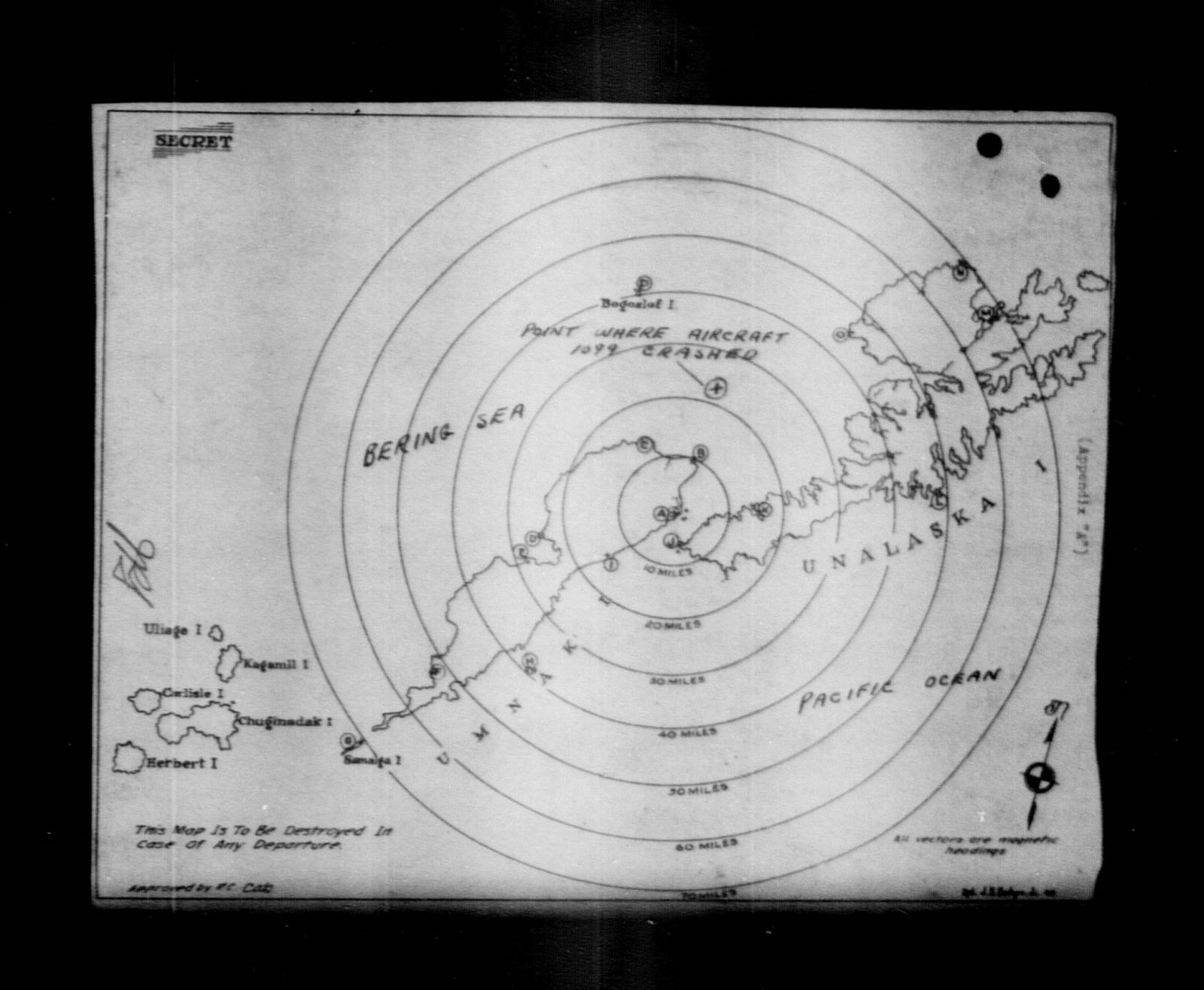
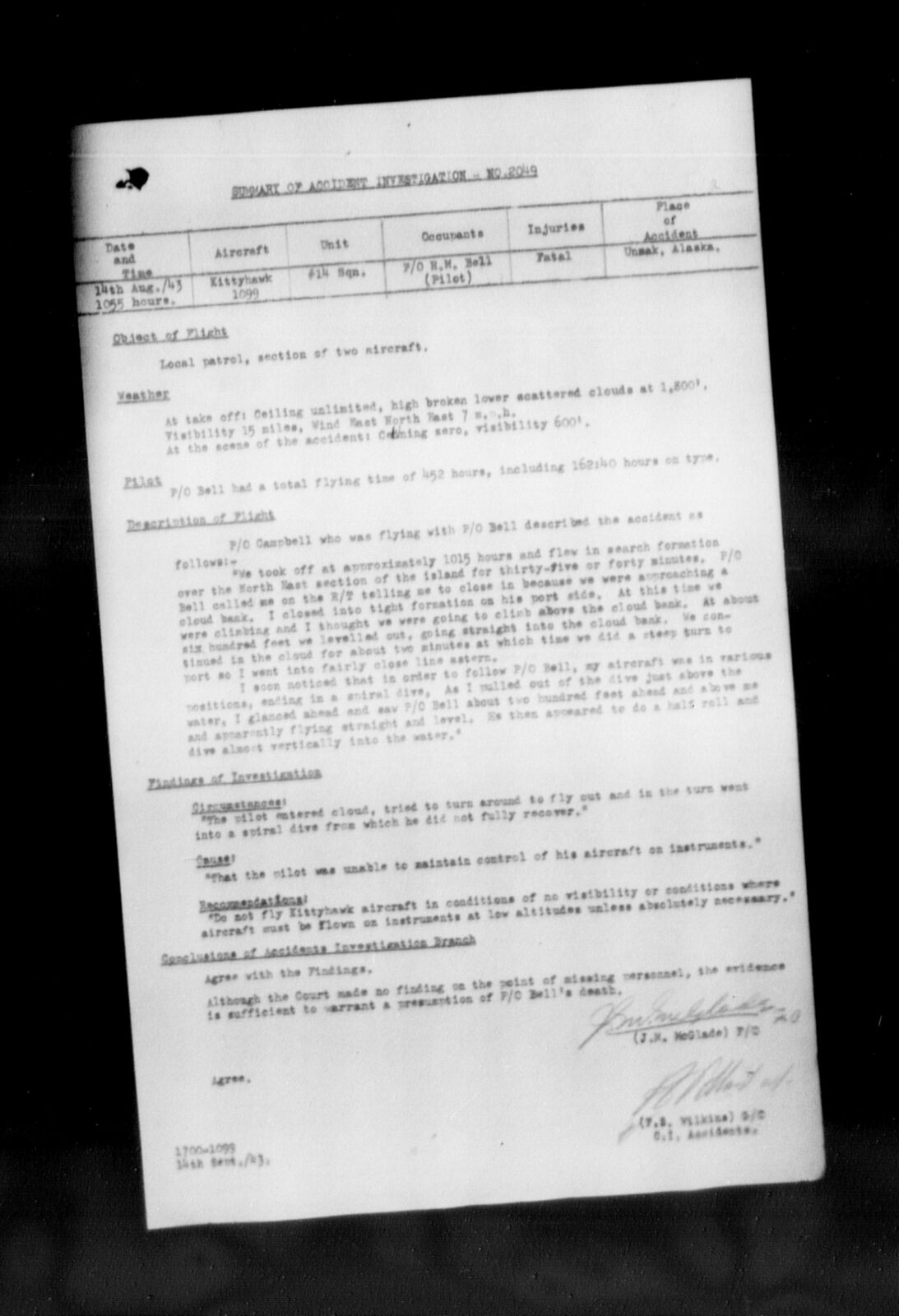

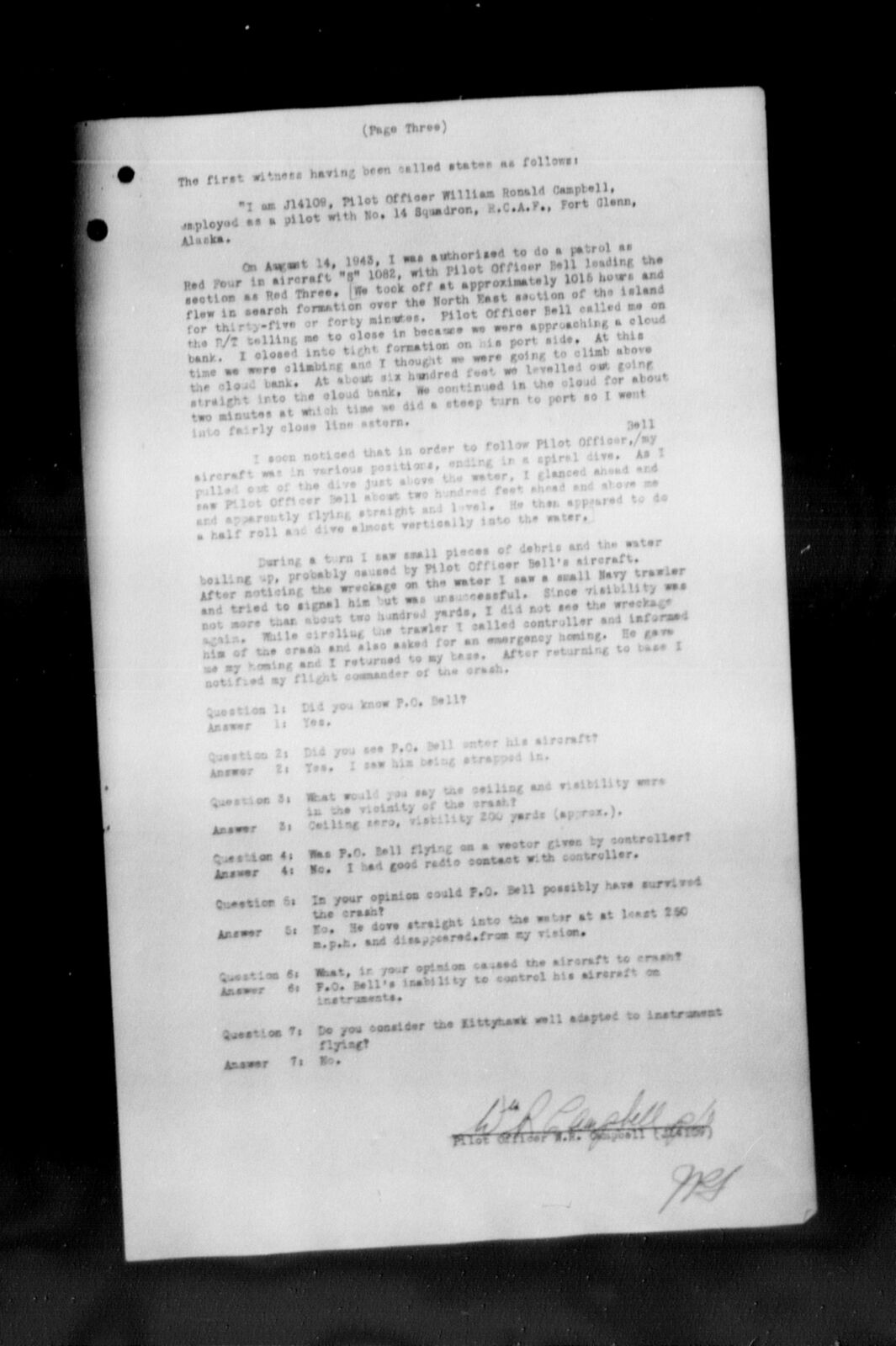

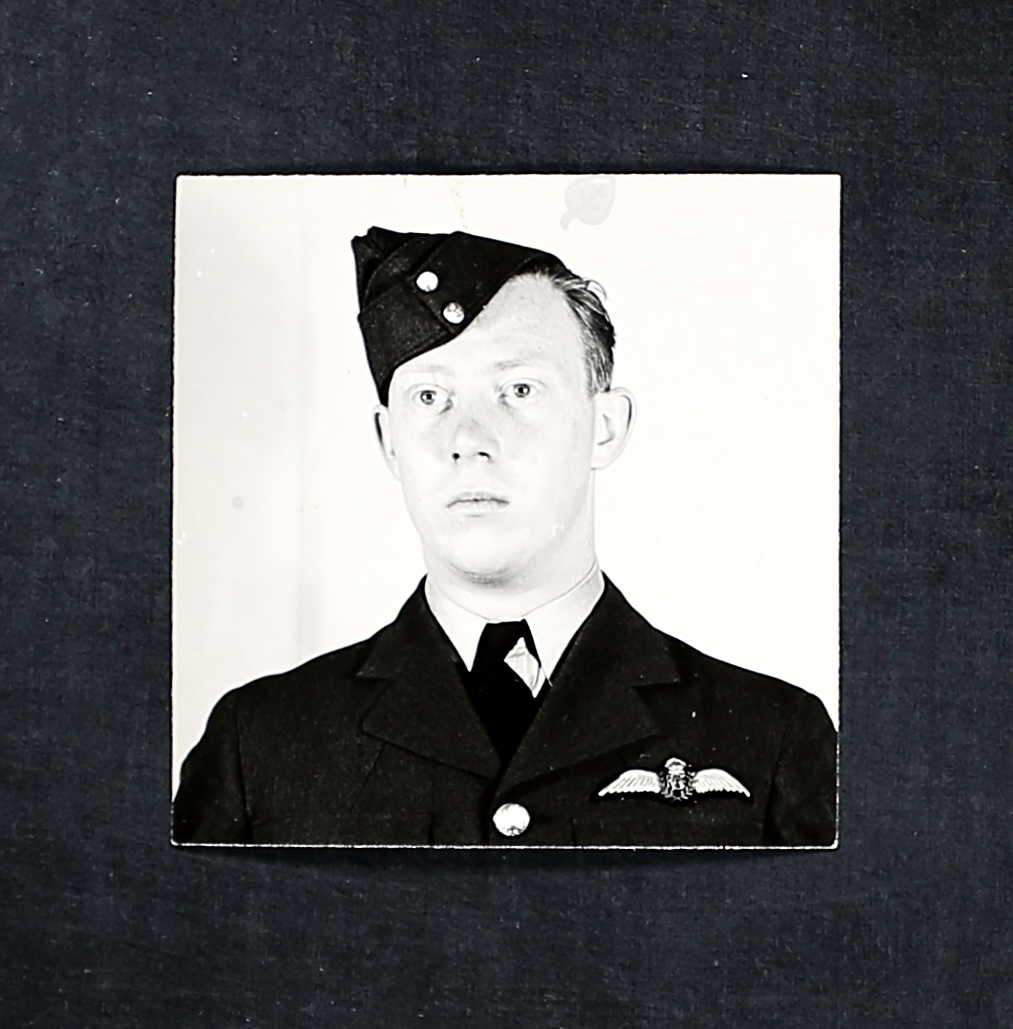
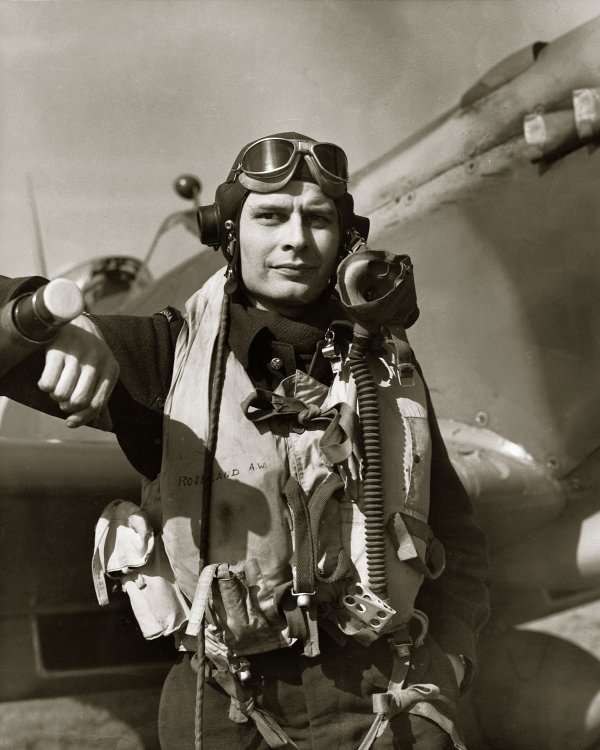
August 7, 1918 - August 14, 1943








Raymond Melvin Bell, born in Springfield, Greene County, Missouri, was the son of Raymond William Bell (1888-1971) and Lena Eugenia (nee Rutledge) Bell (1898-1981) of Hot Springs, Garland, Arkansas. His father was an inventor, and construction engineer. He had one sister, Celestine and one brother, Howard. Their grandmother, Mrs. M.B. Howard lived with them as did a boarder, John Shephard, in 1940. The family was Methodist.
Ray traveled to Windsor, Ontario to enlist in the RCAF, living at Warren’s Nook Tourists’ Home. He was accepted July 3, 1941. On his attestation forms he noted he had the typical childhood ailments including mumps, chickenpox, whooping cough, and measles. When he was 10, he fractured both his forearms just above his wrist joints healing well. “Small, slim, wiry type. Somewhat underweight; believe he will gain satisfactorily under active service conditions. Consider fit in this respect.” Raymond stood 5’7” tall and weighed 118 pounds. His eyes were brown and he had dark brown hair, with a dark complexion. “Good type of lad. Keen, quite good response to all tests. Satisfactory type. Should make good material.”
At Hot Springs, Arkansas from July 7 to December 30, 1940, he took a civil aeronautical course. He received pilot training under the United Stated CPT program. “Total flying time: 32 hours solo, 8 hours dual, 50 hours passenger.”
He had been a jewelry store clerk and prior he worked at a men’s clothing store, each for about a year. He indicated he was a member of the Kappa-Alpha-Phi and the social fraternity of the DeMolays. He indicated his hobby was flying. He liked football, too. He smoked twenty cigarettes over four days and would have one or two highballs a week.
“Lad of average intelligence. Wants fighter pilot and get overseas. Mentally alert. Sincere, good stamina. Not emotional.” His private pilot’s licence was No. 66049-41.
Ray started his journey through the BCATP at No. 4A Manning Depot, St. Hubert, Quebec on July 8, 1941 until he was sent to No. 1 Wireless School in Montreal August 21, 1941. Then he was sent to No. 13 SFTS St. Hubert for a week in September 1941.
Ray was at No. 3 ITS in Victoriaville, Quebec from September 25 to November 21, 1941.
He was then at No. 4 EFTS, Windsor-Mills, Quebec, November 24, 1941 to January 30, 1942. He forfeited two days pay as he was AWL December 30-31, 1941. “A good worker who has made good progress during his course. Shouuld make a good service pilot. Final test: 68.2%. Ground Training: 20th out of 36 in class. 68.1%. Above average, good at all subjects. Attentive to duties. Good deportment.”
He returned to No 13 SFTS, St. Hubert, Quebec for further training, February 16 to June 5, 1942, where he received his Pilot’s Flying Badge. “Flying Training: Neat and careful in his work. Instrument flying a good average. No outstanding faults. Ground Training: An average student. Keen and cheerful. PART III: 25th out of 33 in class. Good appearance, keen and polite. Forgets to think while in the air sometimes due to trying too hard. Will oversome this. A nice personality. Should do well with more experience.”
June 21, 1942, Ray was taken on strength with No. 14 Squadron, Sea Island, BC. From there, the squadron was sent to Umnak, Alaska.
When flying Kittyhawk 1099 on August 14, 1943, he was killed. A Court of Inquiry was struck to investigate.
OBJECT OF FLIGHT: Local patrol, section of two aircraft.
WEATHER: At take off, ceiling unlimited; high broken low scattered clouds at 18000 feet. Visibility 15 miles. Wind: ENE 7 mph. At the scene of the accident, ceiling zero, visibility 600 feet.
DESCRIPTION OF FLIGHT: P/O Campbell who was flying with P/O Bell described the accident as follows: “We took off at approximately 1015 hours influence search formation over the north east section of the island for 35 or 40 minutes. Pilot officer bell called me on the R/T telling me to close in because we were approaching a cloudbank. I closed into tight formation on his portside. At this time, we were climbing and I thought we were going to climb above the cloudbank. At about 600 feet, we leveled out, going straight into the cloudbank. We continued in the cloud for about 2 minutes at which time we did a steep turn to port so I went into fairly close line astern. I soon noticed that in order to follow P/O Bell, my aircraft was in various positions, ending in a spiral dive. As I pulled out of the dive just above the water, I glanced ahead and saw Pilot Officer Bell about 200 feet ahead and above me and apparently flying straight and level. He then appeared to do a half roll and dived almost vertically into the water.”
Four witnesses were called. It was noted that Ray Bell had a total of over 450 hours on a variety of aircraft, including Fleet, Harvard, and Crane. He had 162.40 hours on the Kittyhawk.
FIRST WITNESS: Pilot Officer William Ronald Campbell, J14109. [Note: Campbell was killed on August 1, 1944, Caen, Normandy, France, 442 Squadron, flying a Spitfire.]. “I am employed as a pilot with No. 14 Squadron, RCAF, Fort Glenn, Alaska. On August 14th 1943, I was authorized to do a patrol as Red Four in aircraft S1082 with P/O Bell leading the section's Red Three. We took off at approximately 1015 hours and flew in search formation over the northeast section of the island for 35 or 40 minutes. P/O Bell called me on the R/T telling me to close in because we were approaching a cloud bank. I closed in to tight formation on his port side. At this time, we were climbing and I thought we were going to climb above the cloud bank. At about 600 feet we leveled out going straight into the cloud bank. We continued in the cloud for about 2 minutes at which time we did a steep turn to port so I went into fairly close line astern. I soon noticed that in order to follow pilot officer bell, my aircraft was in various positions, ending in a spiral dive. As I pulled out of the dive just above the water, I glanced ahead and saw P/o Bell almost 200 feet ahead and above me and apparently flying straight and level. He then appeared to do a half roll and dive almost vertically into the water. During a turn, I saw small pieces of debris and the water boiling up, probably caused by P/O Bell’s aircraft. After noticing the wreckage on the water, I saw a small Navy trawler and tried to signal him but was unsuccessful. Since visibility was not more than about 200 yards, I did not see the wreckage again. While circling the trawler, I called controller an informed him of the crash and also asked for an emergency homing. He gave me my homing and I returned to my base. After returning to base, I notified my flight commander of the crash.” Campbell told the court he knew Bell and saw him being strapped into Kittyhawk 1099. “In my opinion, I do not believe P/O Bell could have survived the crash. He dove straight into the water at least 250 mph and disappeared from my vision. I believe the crash was caused by P/O Bell’s inability to control his aircraft on instruments. I do not consider the Kittyhawk well adapted to instrument flying.”
SECOND WITNESS: F/O Arthur Cecil Fanning, J13997. He was in charge of the readiness crew consisting of two sections of two aircraft each. “At approximately 1010 hour, I authorized P/O Bell and P/O Campbell for a local patrol with P/O Bell leading the section…I watched them take off and everything appeared quite normal. I then returned to the alert hut. At approximately 1055 hours, controller phoned and said that an aircraft, Red 3, was down and gave me the position of it when I marked it on the map. I then notified F/L Roseland, the Acting Commanding Officer. The weather was suitable for flying patrol. There was a fog bank about 15 miles northeast of the aerodrome. I did not dispatch an aircraft to the scene of the accident. I wanted to obtain more information as to the position of and the weather conditions at the scene of the crash. Red 4 was about to land. Red 4 advised me that the weather was unsuitable for a Kittyhawk aircraft in the vicinity of the scene of the accident. F/L Roseland arranged to have a crash boat sent out, and also for a patrol by Navy aircraft. [NOTE: F/L Arnold Roseland, J4116, was killed on July 13, 1944, flying a Spitfire near Normandy, France.]
THIRD WITNESS: LAC W. A. Hopkins, R151330, Rigger. He testified that he saw a pilot coming towards Kittyhawk 1099, which was in the alert revetment opening onto the East-West runway. “He climbed up on the port wing and as he did so, I climbed out of the cockpit, and he got in. I stood on the starboard wing assisting him with his dinghy static line, his parachute harness, and his Sutton harness. The Sutton harness was too loose, so I tightened the starboard side while he adjusted the port side. I asked him if he wanted his oxygen turned on, but he said no. I then went to the port side of the aircraft and stood in front of the port wing. The pilot started the engine and proceeded to taxi out of the revetment onto the runway. When he was well out on the runway, I returned to the alert crew’s tent.” He did not P/O Bell. “It was the first time I had ever seen him. The pilot was satisfied with the condition of the aircraft.”
FOURTH WITNESS: Lt. D. W. Gates, 169060, USNR, stationed at Fort Glenn, Alaska. “on August 14th 1943, at approximately 1130 hours, I received word from base operations that AP .40 of the RCAF had crashed at a point approximately 15 miles North East of Cape Tanak. It was requested that I send an aircraft to search for any sign of the missing aircraft. At 11:40 hours, I dispatched Lieutenant McRaven, pilot of Navy JRF (475A) (Grumman Goose) to search the area in the vicinity of the crash. At 1300 hours, he returned, and I questioned him for any results of his search. His results were all negative, and he could offer no information that might aid the search.”
The US Army Controller’s Log stated that a message on teletype to Base Operations Officer “found one powdered milk container marked Golden State brand in water in large oil slick which continued to surface. Find out of pilot carried waterproof container containing powdered milk or some other liquid. Will continue to circle twenty mile area about oil slick until you advise.” P145 crash boat. The milk container was later considered irrelevant.
FINDINGS OF INVESTIGATION: CIRCUMSTANCES: the pilot entered cloud, tried to turn around to fly out and in the turn went into a spiral dive from which he did not fully recover. CAUSE: That the pilot was unable to maintain control of his aircraft on instruments. RECOMMENDATIONS: Do not fly Kittyhawk aircraft in conditions of no visibility or conditions where aircraft must be flown on instruments at low altitudes unless absolutely necessary at low altitudes.
CONCLUSIONS OF ACCIDENT INVESTIGATION BRANCH (AIB): Agree with findings. Although the court made no finding on the point of missing personnel, the evidence is sufficient to warrant presumption of P/O Bell’s death.
AIB’s comments: This matter taken up with fighter staff officers WAC who reports that recommendation refers to low flying only and does NOT mean that instrument flying in Kittyhawks is to be avoided. Flight Operations Comments: The finding seems sound, but this recommendation is a shocker. If the Kittyhawk is so bad on instruments that pilots should avoid instrument flying in it if possible, shouldn’t it be condemned as a service aeroplane? If pilots are told not to fly on instruments except in emergency, this is likely to spin properly when the emergency does arise. I’ve never seen a Kittyhawk, I am afraid, but my ____ is that the recommendation should have been that pilots be given conduct and assiduous practice in instrument flying in it until they are quite happy about it. Do you agree?"
In mid-February 1944, Mr. Bell received a letter to inform him that there was no further information about his son and was proposed to take action to presume his death for official purposes.
On November 17, 1943, in a confidential report, Raymond was noted as a “keen flyer and very skillful in operational flying.” On December 30, 1943: “This officer missing in Bering Sea since August 1943. Recommended retention in service. Recommend that he be posted as ‘presumed dead.’”
In late October 1955, Mrs. Bell received a letter informing her that since her son had no known grave, his name would appear on the Ottawa Memorial.